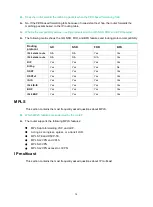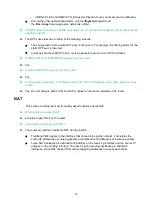
16
IGMPv3 IS_EX and IGMPv3 TO_EX reports that do not carry multicast source addresses.
•
Among the other optional parameters, only the
fragment
keyword and
the
time-range
time-range-name
option take effect.
Q.
The RPF check fails after the MSDP peer switchover in inter-domain multicast routing. What are the
possible reasons?
A.
The RPF check fails due to either of the following reasons:
•
The configuration for the static RPF peer is not correct. For example, the filtering policy for the
static RPF peer is incorrect.
•
Loops exist between MSDP peers, causing packets to arrive at non-RPF interfaces.
Q.
Is BIDIR-PIM or IPv6 BIDIR-PIM supported by the router?
A.
Yes.
Q.
Is inter-AS MD VPN supported by the router?
A.
Yes.
Q.
Is IP multicast unavailable if I configure both of VPLS and IP multicast on the same interface of the
router?
A.
Yes. Do not configure both of VPLS and IP multicast on the same interface of the router.
NAT
This section contains the most frequently asked questions about NAT.
Q.
Which cards can support NAT?
A.
All cards support NAT on the router.
Q.
How does the router perform NAT?
A.
The router can perform traditional NAT and twice NAT:
•
Traditional NAT applies to the interface that connects the public network. It translates the
source IP addresses of outgoing packets and destination IP addresses of incoming packets.
•
Twice NAT translates the destination IP address on the receiving interface and the source IP
address on the sending interface. The receiving and sending interfaces are both NAT
interfaces. Twice NAT allows VPNs with overlapping addresses to access each other.



































